There are millions of trailers in the U.S. Some haul horses, others carry boats and cars, and many are used for camping. For newcomers to the towing game, hitching up a trailer and heading down the highway can be a daunting task. Do it right, and you'll have an enjoyable trip. Get it wrong, and you could end up stranded--or worse. Here are some tips to keep your adventure from ending in disaster.
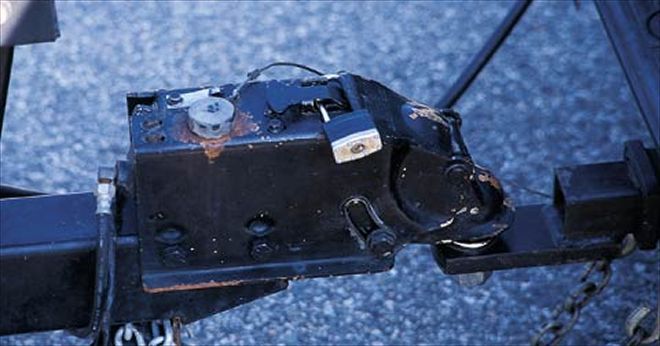
| 163 0212 HOW 2 Z
Before You Tow Preparation is key. This starts when you buy your trailer and tow vehicle. Even though people screw this up every day, it's one of the simplest parts of towing. It revolves around numbers. Make sure your tow vehicle with can haul the load. Know the trailer-towing weight ability of your vehicle, but the number that really counts is the gross combined weight rating (GCWR). This is the weight of the tow vehicle, passengers, cargo, and the trailer (including what's on or in it). Don't be fooled into thinking that if your truck can tow 5000 lb and you have a 4000-lb camper trailer, you're good to go. Once you put two motorcycles in the truck bed, four adults in the cab, and fill the gas tank, you're more than likely over the GCWR, which is unsafe.
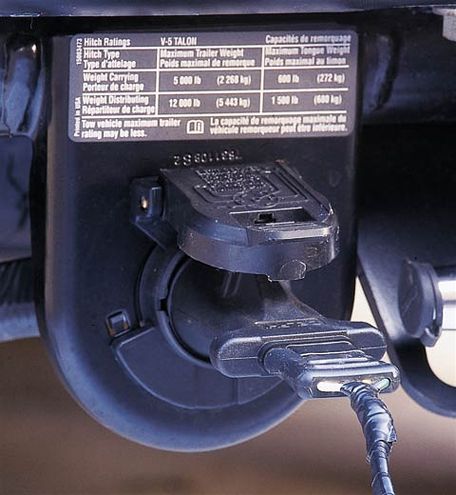
| 163 0212 HOW 1 Z
Choosing the proper hitch is next. Look at the trailer's overall weight or gross trailer weight (GTW) to determine the hitch that's needed. There are two kinds: fifth-wheel and tongue. The fifth-wheel, also known as a gooseneck, mounts in the pickup bed. It's a superior design borrowed from commercial semi rigs, and it requires a matching, often expensive trailer. Tongue hitches, the most popular, come in two types. A weight-carrying hitch is one that carries all the weight of the trailer on the tongue. A better unit is the weight-distributing hitch that transfers much of the trailer's tongue weight through torsion bars to the tow-vehicle's frame. These hitches are able to handle heavier trailers and are less prone to sway problems. There are five classes or sizes of tongue hitches, and it's important to choose the correct class for your application.
Class I: 1000-2500-lb GTW
Class II: 3500-4000-lb GTW
Class III: 6000-lb GTW (tongue), 10,000 lb (WD hitch)
Class IV: 8000-lb GTW (tongue), 12,000 lb (WD hitch)
Class V: 10,000-lb GTW (tongue), (WD hitch)
Besides the proper tow vehicle and hitch, there are several items you should pay attention to before hitting the road.
Trailer Brakes Many states require a separate braking system for trailers that weigh more than 1500 lb loaded. There are two types of trailer braking systems: Electronically controlled brakes provide automatic and manual control for trailer brakes by way of a control unit mounted in the tow vehicle. However, if you want to tow your trailer with different vehicles, surge brakes are the way to go. Hydraulically activated by a master cylinder at the junction of the hitch and trailer tongue, surge brakes are automatically applied when you slow the tow vehicle. Both systems require a safety breakaway switch to activate the trailer brakes should the trailer become disconnected from the tow vehicle on the road.
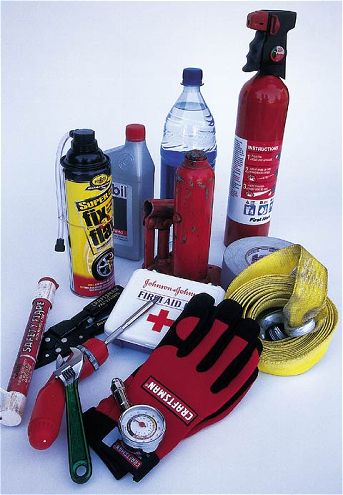
| 163 0212 HOW 3 Z
Proper Wiring Federal law requires trailers to have taillights, brake lights (even if the trailer doesn't have brakes), side-marker lights, turn signals, and side and rear reflectors. Some trailers must also have backup lights. To provide power, a connector is hooked into the tow-vehicle's electrical system. Many tow-vehicle manufacturers offer a seven-way connector that may include an electric brake signal, power supply, and backup lights, in addition to basic lighting functions. Because the wiring systems of many tow vehicles use separate wires for turn signals and stoplights, you may need to purchase a taillight converter that combines these wires to connect to the trailer lighting system. Most factory-installed towing packages include a trailer wire harness that will perform this function if required. If you tow more than one type of trailer, you also may need to purchase an adapter to accommodate differences in the wiring systems.
Loading and Weight Distribution The ability to handle and control your tow vehicle and trailer is greatly improved when cargo is properly loaded and distributed. It's important to load the trailer so about 60 percent of the weight is on the tongue and the cargo is evenly distributed from side to side. Secure and brace all items to prevent them from moving during travel. Most trailers and tow vehicles also should be level (parallel to the ground). Check the instructions from your trailer manufacturer to make sure this is correct for your combination of vehicles.
Tire Inflation More than one person has set out on a trip without checking pressure in trailer and tow-vehicle tires and paid the price. Most tires require more air pressure when the load is increased. Check the tow-vehicle's owner's manual as most manufacturers raise tire-pressure settings for heavily loaded vehicles or those that are towing.
Safety Checklist Before each trip, verify that wiring, lights, hitch, brakes, and tires are in good shape and operating properly. Adjust mirrors before taking off. Be sure the load is placed so the tow vehicle and trailer are both level.
Proper Hitch HookupMany towing problems can be traced to the area around the hitch. Avoid disasters by following a few trailer-hitching ground rules for a tow vehicle.
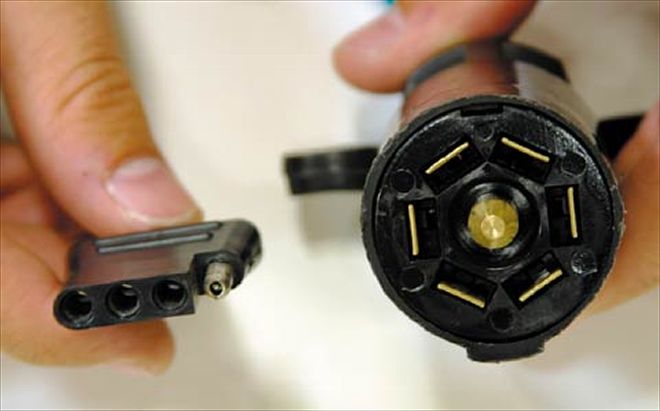
| 163 0212 HOW Plugs Z
Wiring/Connector This is the area that causes trailer users the most heartache. Make sure the plug and receptacle are in good shape and the plug stays put while on the road. Wiring must be routed to avoid dragging or snagging on the safety chains. Also, the wiring must be long enough so that it's not put in tension when turning sharply.
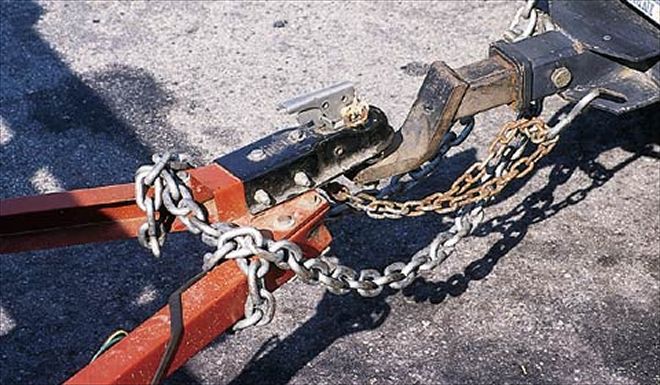
| 163 0212 HOW 4 Z
Safety Chains Connect safety chains properly by crossing them under the trailer's tongue and fastening them to the tow-vehicle chassis or hitch receiver using positive-latching devices rather than "S" hooks, so they can't bounce loose. Leave enough slack so the chains don't become tight when turning sharply, but avoid leaving too much slack as the chains will drag. Remember, chains are there in case of a hitch failure, which could be a violent episode should it occur, so be sure the chains are heavy-duty.
Breakaway Switch/Cable In the event your trailer becomes decoupled from the tow vehicle, most state laws require a breakaway device (either electric or mechanical) to apply the trailer brakes, helping to stop the wayward unit.
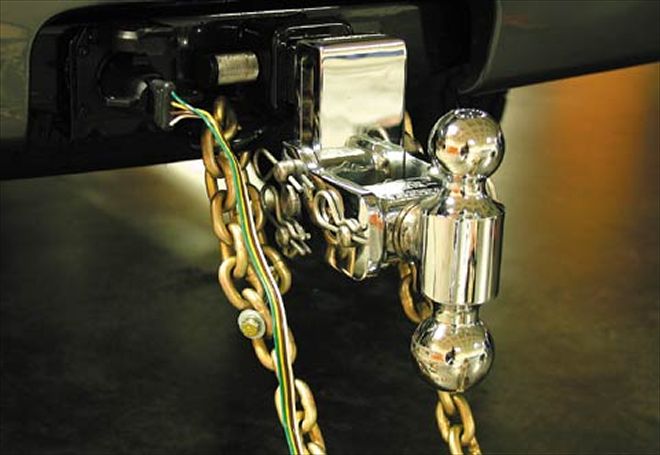
| 163 0212 HOW Rig Z
Tongue Jack This one may seem simple, but we've seen trailers going down the road with the tongue jack dragging. Secure it in place to ensure this doesn't happen.
Hitch/Receiver There are several things to do to ensure a trailer stays attached to the tow vehicle. Use the proper-size ball for the hitch (most balls and couplers have the size stamped into them). Make sure the ball is tight and lube it often to avoid binding. If the hitch coupler has a hydraulic brake unit built in, make sure there's plenty of brake fluid in the reservoir. It's a good idea to use a bolt or other device to secure the latch to keep it from coming open en route.
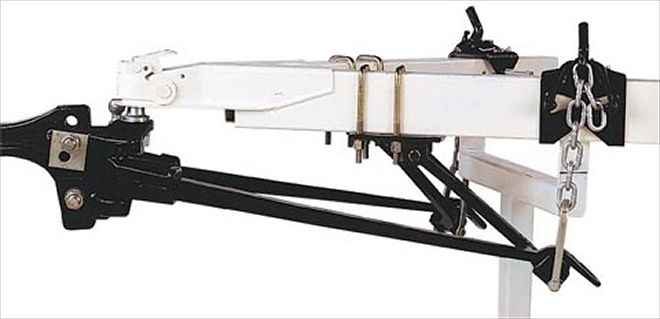
| 163 0212 HOW 6 Z
Sway Controls Sway controls can lessen the effects of sudden maneuvers, wind gusts, and buffeting caused by other vehicles. Think of them as shock absorbers for your trailer hitch. They're ideal for units with large surface areas, such as travel trailers. Adjustable friction models can control trailers with low tongue weights.
Towing Tips To Live ByMany people underestimate what it takes to tow a trailer. Generally, proper towing is a question of common sense.
* The biggest difference between towing and driving without a trailer is the time it takes for everything to happen. Acceleration and braking take longer when you're pulling a trailer, while skids or losing control of your rig can happen more quickly.
* Slow down and allow plenty of room between your vehicle and traffic ahead.
* Don't make jerky steering or braking moves as this could cause you to lose control.
* Use care when descending steep hills, as it's easy to overheat the brakes. Use a lower gear and apply brakes periodically to keep speed in check.
* On the highway, wind buffeting can move a trailer around. In these cases, slower speeds will help.
* In town, you may need to make wider turns with your trailer hooked up.
* Never allow people to ride inside an enclosed trailer. Besides being illegal in many states, it's dangerous.
* Backing should be done slowly to avoid jackknifing the trailer and damaging the hitch. Remember, when backing up, the trailer will move in the opposite direction of the tow vehicle. Use a spotter.
* Be sure there's plenty of room to turn around before heading into a dead-end situation.
 | 163 0212 HOW 2 Z
Before You Tow
| 163 0212 HOW 2 Z
Before You Tow | 163 0212 HOW 1 Z
Choosing the proper hitch is next. Look at the trailer's overall weight or gross trailer weight (GTW) to determine the hitch that's needed. There are two kinds: fifth-wheel and tongue. The fifth-wheel, also known as a gooseneck, mounts in the pickup bed. It's a superior design borrowed from commercial semi rigs, and it requires a matching, often expensive trailer. Tongue hitches, the most popular, come in two types. A weight-carrying hitch is one that carries all the weight of the trailer on the tongue. A better unit is the weight-distributing hitch that transfers much of the trailer's tongue weight through torsion bars to the tow-vehicle's frame. These hitches are able to handle heavier trailers and are less prone to sway problems. There are five classes or sizes of tongue hitches, and it's important to choose the correct class for your application.
Class I: 1000-2500-lb GTW
| 163 0212 HOW 1 Z
Choosing the proper hitch is next. Look at the trailer's overall weight or gross trailer weight (GTW) to determine the hitch that's needed. There are two kinds: fifth-wheel and tongue. The fifth-wheel, also known as a gooseneck, mounts in the pickup bed. It's a superior design borrowed from commercial semi rigs, and it requires a matching, often expensive trailer. Tongue hitches, the most popular, come in two types. A weight-carrying hitch is one that carries all the weight of the trailer on the tongue. A better unit is the weight-distributing hitch that transfers much of the trailer's tongue weight through torsion bars to the tow-vehicle's frame. These hitches are able to handle heavier trailers and are less prone to sway problems. There are five classes or sizes of tongue hitches, and it's important to choose the correct class for your application.
Class I: 1000-2500-lb GTW  | 163 0212 HOW 3 Z
Proper Wiring
| 163 0212 HOW 3 Z
Proper Wiring | 163 0212 HOW Plugs Z
Wiring/Connector
| 163 0212 HOW Plugs Z
Wiring/Connector | 163 0212 HOW 4 Z
Safety Chains
| 163 0212 HOW 4 Z
Safety Chains | 163 0212 HOW Rig Z
Tongue Jack
| 163 0212 HOW Rig Z
Tongue Jack  | 163 0212 HOW 6 Z
Sway Controls
| 163 0212 HOW 6 Z
Sway Controls